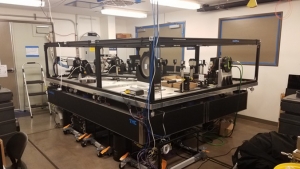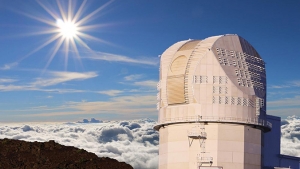Never-before-seen images of Sun released from world’s largest solar telescope
From UH News, January 29, 2020
Researchers and the general public are getting a glimpse of the most detailed view ever of the Sun, thanks to the National Science Foundation’s Daniel K. Inouye Solar Telescope (DKIST) on Haleakalā, Maui. The imagery, released January 29, 2020, shows cell-like structures the size of Texas roiling on the Sun’s surface and the tiny footprints of magnetism that reach into space.
Scientists operating the Inouye Solar Telescope said the unprecedented detail demonstrates the sheer power of the ground-based telescope to map the magnetic fields within the Sun’s corona, where solar eruptions occur that impact life on Earth. Such activity can disrupt air travel, cause blackouts, and even disable technologies such as GPS used for navigation.
“It is literally the greatest leap in humanity’s ability to study the Sun from the ground since Galileo’s time. It’s a big deal,” said Professor Jeff Kuhn of the University of Hawaiʻi at Mānoa’s Institute for Astronomy (IfA).

This instrument built by IfA will allow the Inouye Telescope to view the Sun’s magnetic fields.
DKIST will be even more powerful after a suite of state-of-the-art instruments come online in the coming months. A team of IfA scientists constructed two complex infrared instruments that ultimately will allow scientists to predict the Sun’s magnetic activity and solar storms. The first is called the Cryogenic Near-Infrared Spectropolarimeter (CryoNIRSP). The nearly 2-ton instrument is designed to measure the Sun’s magnetism beyond the visible solar disk. The second, called the Diffraction-Limited Near-IR Spectropolarimeter (DL-NIRSP), will allow DKIST to view the evolution of the Sun’s magnetic fields in extreme detail.
Related UH News story: Hawaiʻi-built infrared instrument for world’s largest solar telescope catches first rays, April 12, 2017
“These instruments use sensitive infrared technology and complex optics that reveal sunspots and small magnetic features, and how their magnetism reaches into space. With these new tools we expect to learn how the Sun interacts with the Earth,” Kuhn said.
Solar research at the House of the Sun
DKIST is by far the world’s largest and most powerful solar telescope, and stands on the 10,000-foot summit of Maui’s majestic Haleakalā, which literally means “the house of the Sun.” Haleakalā’s favorable atmospheric conditions provide the best location for it, as proven by the National Solar Observatory and IfA during a world-wide site survey.

Inouye Telescope (Photo courtesy: National Science Foundation)
The unusual optical design of the 4-meter telescope allows it to measure the Sun’s magnetism out into space. It is also modeled after the UH/IfA designed proof-of-concept SOLARC telescope, in operation on Haleakalā since 2001. Once the Inouye Solar Telescope becomes fully operational in July 2020, UH community astronomers will be major users of the telescope while doing pioneering solar research.
UH Maui College was also awarded a $20-million grant from the National Science Foundation, to engage Native Hawaiian students to pursue careers in science, technology, engineering and math (STEM). The Akeakamai I Ka Lā Hiki Ola: Scientific Exploration Beneath the Life-Bringing Sun program will incorporate traditional cultural practices within its curriculum. The grant awards the program $2 million each year over the course of a decade. Part of the funding will go toward financial aid and paid internships for Native Hawaiians.
While the 4-meter solar telescope isn’t set to be completed until June, scientists will continue preliminary tests by making observations of the Sun in the coming months. But pointing a telescope directly at the scalding sphere comes with challenges. The Sun’s sweltering surface temperature is about 6,000 degrees Celsius. A specialized cooling system is in place to protect DKIST from massive amounts of heat.
“The focus of the telescope mirror is hot enough to melt metal within a short time. To deal with these heat problems we make the equivalent of a swimming pool full of ice every night to provide cooling for the optics and structure during the day,” said Inouye Solar Telescope Director Thomas Rimmele. More than 7 miles of piping will distribute coolant throughout the observatory.
The state-of-the-art telescope was renamed in honor of the late Sen. Daniel K. Inouye, a strong supporter of STEM education.
* * * * *
Coverage:
Flashback:
How Maui Got its Telescope Built—Despite Protesters Objections
SA: … Construction of the Thirty Meter Telescope has been blocked at Mauna Kea for more than a month by a Native Hawaiian protest that seeks to safeguard what many regard a sacred mountain against a lawfully permitted project.
Meanwhile, another cutting-edge observatory, the Daniel K. Inouye Solar Telescope atop Haleakala, is nearing completion after escaping a similar fate during protests in 2015 and 2017 involving some of the same people embroiled in the TMT protests.
While the Maui incidents weren’t exactly on the same scale, former Maui Mayor Alan Arakawa says authorities handling the TMT protest would have been wise to follow Maui’s example.
“We didn’t fool around,” Arakawa recalled. “It was, this is what the law is, and this is how you enforce it.”
Arakawa said the time for negotiation with TMT protesters was long past as the $1.4 billion project survived a lengthy governmental review plus legal challenges that went all the way to the state Supreme Court.
“It comes down to a simple question: Are we a community of laws, or are we a community where anyone who raises an objection can defy those laws?” he said. “We are legally bound to uphold the laws of the state of Hawaii and the U.S. That’s our obligation.
“We’re going to let a handful of people stop what most people believe is a good project? It hardly makes sense in a democratic society,” he said.
Arakawa said authorities should have taken decisive action at the beginning of the TMT protest because the task is only going to get harder….
After demonstrators blocked an initial shipment, Maui police were ready for subsequent ones, moving decisively to enforce the law twice in 2015 and once in 2017, each time facing between 100 and 200 demonstrators, some of whom traveled to Maui from other islands.
Police arrested 34 people over the three protests, including 20 in one night in 2015. Among those arrested were Kahookahi Kanuha, Kaleaikoa Kaeo and Lanakila Manguil, each of them leaders of the Mauna Kea “protectors.”
Arakawa said Maui police gave clear instructions about what would happen if the demonstrators deliberately tried to obstruct the trucks. They also came with enough officers to handle the job when the activists did get in the way, he said.
“Nobody was beaten up or physically hurt,” he said….
Related: SHOPO: Police plans to arrest TMT protesters Disrupted by ‘Politics’
read … Hawaii leaders needed to be more decisive in enforcing law on Mauna Kea, former Maui mayor says